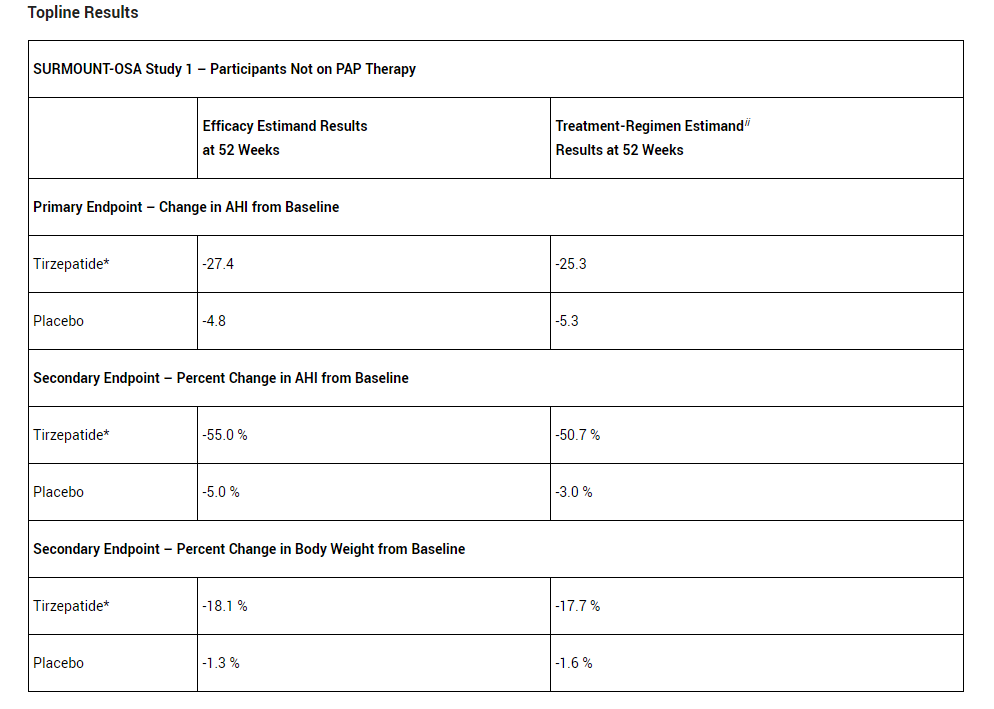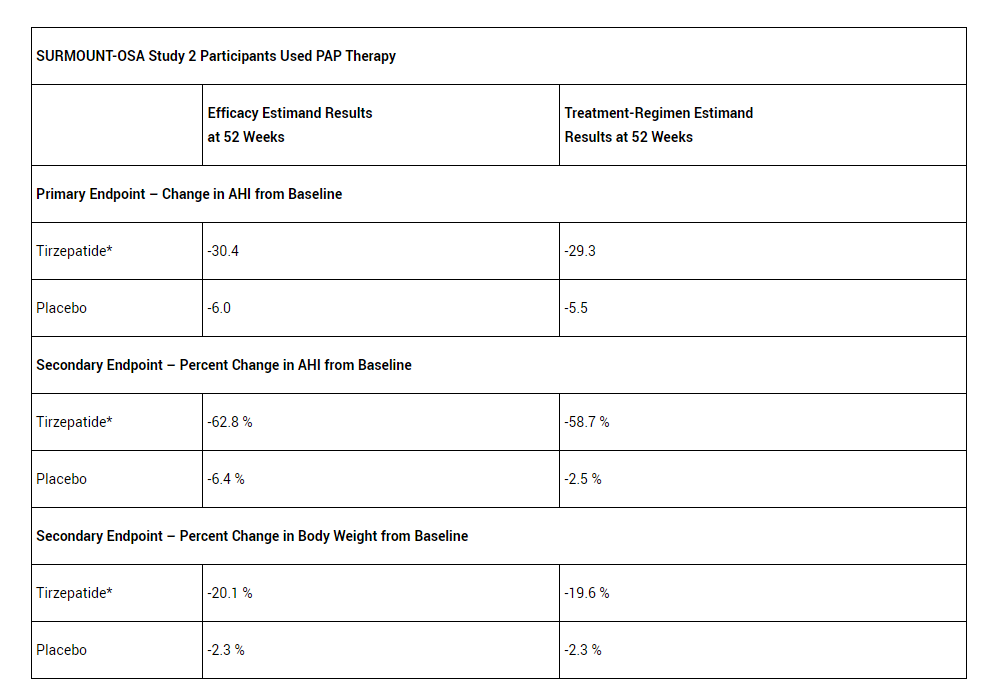Tirzepatide achieved a mean apnea-hypopnea index reduction of up to 63% (about 30 fewer events per hour), meeting all primary and key secondary endpoints in two phase 3 clinical trials
Tirzepatide meaningfully improved sleep apnea symptoms in those with moderate-to-severe OSA and obesity with and without PAP therapy, and based on these results Lilly plans to submit these data for global regulatory reviews
INDIANAPOLIS, April 17, 2024 /PRNewswire/ -- Eli Lilly and Company (NYSE: LLY) today announced positive topline results of the SURMOUNT-OSA phase 3 clinical trials that showed tirzepatide injection (10 mg or 15 mg) significantly reduced the apnea-hypopnea index (AHI) compared to placebo, achieving the primary endpoints. Percentage change in AHI was a key secondary endpoint in both studies. AHI records the number of times a person's breathing shows a restricted or complete block of airflow per hour of sleep and is used to evaluate the severity of obstructive sleep apnea (OSA) and the effectiveness of treatment outcomes. Tirzepatide is the only approved GIP (glucose-dependent insulinotropic polypeptide) and GLP-1 (glucagon-like peptide-1) treatment for chronic weight management, commercialized as Zepbound® in the U.S. and Mounjaro® in some global markets outside the U.S.
SURMOUNT-OSA Study 1 evaluated tirzepatide in adults with moderate-to-severe OSA and obesity who were not on positive airway pressure (PAP) therapy for 52 weeks. For the efficacy estimandi, at 52 weeks, tirzepatide led to a mean AHI reduction from baseline of 27.4 events per hour compared to a mean AHI reduction from baseline of 4.8 events per hour for placebo. In key secondary outcomes, tirzepatide led to a mean AHI reduction from baseline of 55.0% compared to 5.0% from baseline for placebo; tirzepatide also led to a mean body weight reduction of 18.1% from baseline, compared to 1.3% from baseline for placebo.
SURMOUNT-OSA Study 2 evaluated tirzepatide in adults with moderate-to-severe OSA and obesity who were on and planned to continue to use PAP therapy for 52 weeks. In this population for the efficacy estimand, at 52 weeks, tirzepatide led to a mean AHI reduction from baseline of 30.4 events per hour compared to a mean AHI reduction from baseline of 6.0 events per hour for placebo. In key secondary outcomes, tirzepatide led to a mean AHI reduction from baseline of 62.8% compared to 6.4% from baseline for placebo; tirzepatide also led to a mean body weight reduction of 20.1% from baseline, compared to 2.3% from baseline for placebo.
The weight loss observed at 52 weeks with tirzepatide (10 mg and 15 mg) across the two studies was nearly 20% in a patient population that was comprised of approximately 70% males, who are known to achieve less weight loss with incretin therapy than females.
OSA is a sleep-related breathing disorder characterized by complete or partial collapses of the upper airway during sleep, which can lead to apnea or hypopnea and a potential decrease in oxygen saturation and/or waking from sleep. OSA can have serious cardiometabolic complications, contributing to hypertension, coronary heart disease, stroke, heart failure, atrial fibrillation and type 2 diabetes.1
"OSA impacts 80 million adults in the U.S., with more than 20 million living with moderate-to-severe OSA. However, 85% of OSA cases go undiagnosed and therefore untreated,2,3" said Jeff Emmick, MD, Ph.D., senior vice president, product development, Lilly. "Addressing this unmet need head-on is critical, and while there are pharmaceutical treatments for the excessive sleepiness associated with OSA, tirzepatide has the potential to be the first pharmaceutical treatment for the underlying disease."


*Tirzepatide MTD is maximum tolerated dose of 10 mg or 15 mg once-weekly. The starting dose of 2.5 mg tirzepatide was increased by 2.5 mg every four weeks until maximum tolerated dose was achieved. Participants who tolerated 15 mg continued on 15 mg as their maximum tolerated dose. Participants who tolerated 10 mg but did not tolerate 15 mg continued on 10 mg as their maximum tolerated dose.
The overall safety profile of tirzepatide in SURMOUNT-OSA studies was similar to previously reported SURMOUNT and SURPASS trials. The most commonly reported adverse events in SURMOUNT-OSA were gastrointestinal-related and generally mild to moderate in severity. The most commonly reported adverse events for patients treated with tirzepatide were diarrhea, nausea and vomiting in SURMOUNT-OSA Study 1, and diarrhea, nausea and constipation in SURMOUNT-OSA Study 2.
SURMOUNT-OSA trials will be presented during a symposium at the American Diabetes Association's 84th Scientific Sessions on June 21 at 3:45 p.m. ET and submitted to a peer-reviewed journal. Based on these results, Lilly plans to submit to the U.S. Food and Drug Administration (FDA) and other global regulatory agencies beginning mid-year. Lilly received FDA Fast Track designation for moderate-to-severe OSA and obesity.
About SURMOUNT-OSA
SURMOUNT-OSA (NCT05412004) was a multi-center, randomized, double-blind, parallel, placebo-master protocol comparing the efficacy and safety of tirzepatide to placebo in adults living with moderate-to-severe obstructive sleep apnea and obesity who were unable or unwilling to use positive airway pressure (PAP) therapy (Study 1) and those who were and planned to stay on PAP therapy during the duration of the trial (Study 2). Under a master protocol, the trials randomized 469 participants across the U.S., Australia, Brazil, China, Czechia, Germany, Japan, Mexico and Taiwan in a 1:1 ratio to receive tirzepatide maximum tolerated dose (MTD) 10 mg or 15 mg or placebo. The primary objective of both studies was to demonstrate that tirzepatide is superior in change in apnea-hypopnea index (AHI) from baseline at 52 weeks as compared to placebo.
SURMOUNT-OSA utilized a MTD of 10 mg or 15 mg once-weekly. The starting dose of 2.5 mg tirzepatide was increased by 2.5 mg every four weeks until maximum tolerated dose was achieved. Participants who tolerated 15 mg continued on 15 mg as their MTD. Participants who tolerated 10 mg but did not tolerate 15 mg continued on 10 mg as their MTD.
About Lilly
Lilly unites caring with discovery to create medicines that make life better for people around the world. We've been pioneering life-changing discoveries for nearly 150 years, and today our medicines help more than 51 million people across the globe. Harnessing the power of biotechnology, chemistry and genetic medicine, our scientists are urgently advancing new discoveries to solve some of the world's most significant health challenges, redefining diabetes care, treating obesity and curtailing its most devastating long-term effects, advancing the fight against Alzheimer's disease, providing solutions to some of the most debilitating immune system disorders, and transforming the most difficult-to-treat cancers into manageable diseases. With each step toward a healthier world, we're motivated by one thing: making life better for millions more people. That includes delivering innovative clinical trials that reflect the diversity of our world and working to ensure our medicines are accessible and affordable. To learn more, visit Lilly.com and Lilly.com/news, or follow us on Facebook, Instagram and LinkedIn. P-LLY
i The efficacy estimand represents efficacy prior to discontinuation of study drug.
ii The treatment-regimen estimand represents the estimated average treatment effect regardless of treatment discontinuation.
References
1.Javaheri, S, Barbe, F, Campos-Rodriguez, F. et al. Sleep Apnea: Types, Mechanisms, and Clinical Cardiovascular Consequences. J Am Coll Cardiol. 2017 Feb, 69 (7) 841–858. https://doi.org/10.1016/j.jacc.2016.11.069
2.Clarivate DRG. (2021). (rep.). Obstructive Sleep Apnea Epidemiology- Diagnosed prevalent cases.
3.Benjafield AV, Ayas NT, Eastwood PR, Heinzer R, Ip MSM, Morrell MJ, Nunez CM, Patel SR, Penzel T, Pépin JL, Peppard PE, Sinha S, Tufik S, Valentine K, Malhotra A. Estimation of the global prevalence and burden of obstructive sleep apnoea: a literature-based analysis. Lancet Respir Med. 2019 Aug;7(8):687-698. Doi: 10.1016/S2213-2600(19)30198-5. Epub 2019 Jul 9. PMID: 31300334; PMCID: PMC7007763.